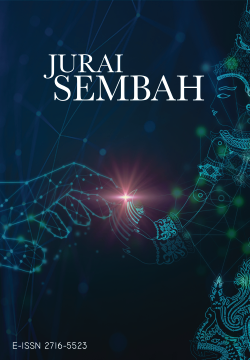Kasurupan: Spirits Taxonomies and Interpretation in the Practice of Kasenian Réak
DOI:
https://doi.org/10.37134/juraisembah.vol1.2.3.2020Keywords:
possession, performance, supernatural beings, taxonomies, West-JavaAbstract
Kasenian réak is a regional variant of the Javanese horse dances from Bandung, Indonesia. Commonly known in the archipelago as jaranan, kuda lumping or jathilan, the Javanese horse dances are a group of ceremonial musical performances during which a group of performers, led by a trance master, undergo voluntary possessions on behalf of spirits of the ancestors and other supernatural beings, under the influence of a musical ensemble. In different possession and trance phenomena around the world recognizing the acting spirit is often the key to communication with the supernatural being and treatment of the possessed. Thus, more or less different and precise taxonomies may be developed in order to do so. In réak, the possessed behaviour is interpreted by the trance master and members of the group in order to meet the spirit’s various demands and act accordingly to manage the possession. The purpose of this article is to examine the spirits’ taxonomies at play in réak as a case study. I do this in order to show in which sense analyses of the phenomenon of possession based on classification often fail to grasp the complexity and thus the significance of the experience. The outcome will underline which benefits can be obtained by a an approach that gives more value to a context-based ethnography of the possessed and its peculiarities than to the development of a general theory of possession with comparative purposes.
Downloads
References
Acciaioli, G. (2016). Culture as art: from practice to spectacle in Indonesia. In J. C. H. Lee & M. Ferrarese (Eds.), Punks, monks and politics: Authenticity in Thailand, Indonesia and Malaysia (pp. 145-164). Rowman & Littlefield.
Azzaroni, G. (1994). Teatro e società a Bali. CLUEB.
Beneduce, R. (2002). Trance e possessione in Africa. Bollati Boringhieri.
Boddy, J. (1994). Spirit possession revisited: Beyond instrumentality. Annual Review of Anthropology, 23, 407-434. https://doi.org/10.1146/annurev.an.23.100194.002203
Boddy, J. (2010). The work of Zâr: Women and spirit possession in northern Sudan. In J. Quack, J. Weinhold & W. S. Sax (Eds.), The problem of ritual efficacy (pp. 113-149). Oxford University Press.
Bourguignon, E. (1976). Possession. Chandler & Sharp Publishers.
Christensen, P. (2014). Modernity and spirit possession in Java: Horse dance and its contested magic. In V. Gottowik (Ed.), Dynamics of religion in Southeast Asia: Magic and modernity (pp. 91-110). Amsterdam University Press.
Cohen, E. (2008). What is spirit possession? Defining, comparing, and explaining two possession forms. Ethnos, 73(1), 101-126. https://doi.org/10.1080/00141840801927558
De Certeau, M. (1970). La possession de Loudun. Gallimard.
Deren, M. (1953). Divine horsemen: The living Gods of Haiti. Thames and Hudson.
Douglas, M. (2013). The Lele of the Kasai. Routledge.
Foley, K. (1990). My bodies: The performer in West Java. TDR, 34(2), 62-80. https://doi.org/10.2307/1146027
Geertz, C. (1976). The religion of Java. University of Chicago press.
Kartomi, M. J. (1973). Music and trance in central Java. Ethnomusicology, 17(2), 163-208. https://doi.org/10.2307/849881
Kartomi, M. J. (1976). Performance, music and meaning of Réyog Ponorogo. Indonesia, 22, 84-130. https://doi.org/10.2307/3350979
Kasmana, K., Setiawan S., Iwan G. & Hafiz A. A. (2018). The belief in the existence of supernatural beings in the community of Moslem Sundanese. Journal of Arts and Humanities, 7(4), 11-21. https://doi.org/10.18533/journal.v7i4.1375
Mauricio, D. E. (2002). Jaranan of east Java: An ancient tradition in modern times. University of Hawaii.
Monteanni, L. (2018). L’intrattenimento Sacro: Per un’analisi della danza sundanese del cavallo. [Unpublished master’s thesis]. University of Bologna.
Monteanni, L. (2020). Il réak di Bandung tra rituale cerimoniale e intrattenimento popolare: Una tradizione contemporanea sundanese. Antropologia e Teatro. Rivista di Studi, 12, 29-41. https://doi.org/10.6092/issn.2039-2281/10883
Rapoport, E. (2018). Jathilan horse dance: Spirit possession beliefs and practices in the present-day Java. IKAT: The Indonesian Journal of Southeast Asian Studies, 2(1), 1-17. https://doi.org/10.22146/ikat.v2i1.37389
Talamonti, A. (2005). La carne convulsiva. Etnografia dell’esorcismo. Liguori.
Valeri, V. (1999). Uno spazio tra sé e sé. L’antropologia come ricerca del soggetto. Donzelli.
Van Groenendael, C. (2008). Jaranan: The horse dance and trance in East Java. KITLV press.



